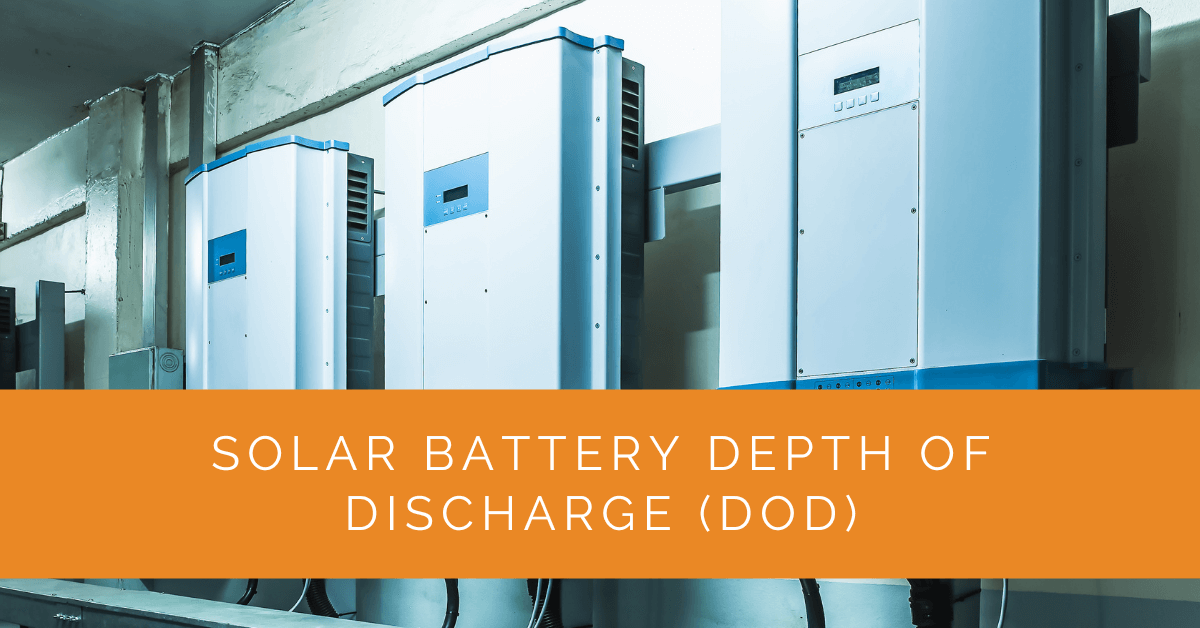As solar energy systems become increasingly popular, it’s important to understand the factors that influence their performance and longevity. One critical factor is solar batteries’ depth of discharge (DoD). In this article, we will explore the significance of DoD in solar battery systems, its impact on battery performance and cycle life, and strategies to maximize the lifespan and efficiency of your solar battery storage.
Contents
- 1 Key Takeaways
- 2 What is Depth of Discharge (DoD)?
- 3 The Importance of DoD in Solar Battery Storage
- 4 Managing Depth of Discharge in Battery Systems
- 5 Maximizing Battery Life with DoD Considerations
- 6 Battery Depth of Discharge (DoD) vs. Cycle Life: A Comparative Analysis
- 7 Case Study: Optimizing Solar Battery Depth of Discharge for Enhanced Performance
- 8 Expert Insights From Our Solar Panel Installers About Understanding Solar Battery Depth of Discharge (DoD)
- 9 Experience Solar Excellence with Us!
- 10 Conclusion
- 11 FAQ
Key Takeaways
- Depth of discharge (DoD) plays a crucial role in the performance and lifespan of solar batteries, as deeper discharges can lead to shorter battery lifespans.
- Following battery manufacturers’ recommended DoD limits and balancing DoD with battery cycle life is essential for maximizing the efficiency and longevity of solar battery storage.
- Setting appropriate DoD limits, such as a DoD of around 50%, and implementing proper charging practices can help extend the life of solar batteries and optimize energy storage capacity.
What is Depth of Discharge (DoD)?
Defining Depth of Discharge: Understanding the Concept
Depth of Discharge (DoD) refers to the percentage of a battery’s capacity that has been discharged relative to its total capacity. For instance, if a battery with a capacity of 10 kilowatt-hours (kWh) has discharged 5 kWh, the DoD is 50%. DoD is a crucial metric in determining the amount of energy extracted from a battery and plays a significant role in its overall performance and lifespan.
DoD vs. Battery Capacity: Unraveling the Relationship
The battery capacity represents the total energy a battery can store when fully charged. It is important to note that the usable capacity of a battery is typically less than its rated capacity. The difference between the rated and usable capacity accounts for efficiency losses, voltage limits, and safety margins. DoD, on the other hand, refers to the amount of usable capacity that has been discharged. Understanding the relationship between DoD and battery capacity is essential for maximizing the efficiency and lifespan of solar batteries.
The Importance of DoD in Solar Battery Storage
Optimizing Battery Lifespan: The Role of Depth of Discharge
The depth of discharge significantly impacts the lifespan of solar batteries. Generally, deeper discharges can result in shorter battery lifespans. Batteries are subjected to various chemical reactions during charge and discharge cycles, and repeated deep discharges can accelerate degradation and reduce the battery’s useful life. Therefore, managing DoD is critical to maximizing the longevity of your solar battery storage system.
Battery Manufacturers’ DoD Recommendations: Making Informed Decisions
Battery manufacturers typically provide recommended DoD limits for their products. These recommendations are based on extensive testing and research to ensure optimal performance and longevity. It is crucial to adhere to these recommendations to prevent excessive wear and premature battery degradation. Following the manufacturer’s guidelines can effectively balance energy storage capacity and battery lifespan.
Understanding the Trade-off: DoD and Battery Cycle Life
The cycle life of a battery refers to the number of charge and discharge cycles it can undergo before its capacity significantly degrades. The depth of discharge directly affects the number of cycles a battery can endure. Shallow discharges, where the battery is not fully discharged, generally allow for more cycles. On the other hand, deep discharges can reduce the number of cycles a battery can undergo. Striking a balance between DoD and the desired battery cycle life is crucial when designing a solar energy storage system.

Managing Depth of Discharge in Battery Systems
Calculating Depth of Discharge: Understanding kilowatt-hours (kWh)
To calculate the depth of discharge for your solar battery, you need to determine the energy consumed or discharged from the battery in kilowatt-hours (kWh). This can be achieved by measuring the energy flowing into and out of the battery during charge and discharge cycles. Monitoring systems and charge controllers can provide accurate energy flow measurements, helping you calculate and manage DoD effectively.
Setting DoD Limits for Battery Systems: Best Practices and Considerations
To optimize the performance and lifespan of your solar battery system, it is crucial to set appropriate DoD limits. While battery manufacturers provide recommendations, it is essential to consider your specific energy storage requirements and system constraints. Setting conservative DoD limits, such as limiting the maximum to 80%, can help ensure longer battery lifespans and reliable energy storage.
Battery Banks and DoD: Strategies for Effective Utilization
Battery banks, consisting of multiple batteries connected in series or parallel, can provide enhanced energy storage capacity. When configuring battery banks, it is important to consider DoD distribution across individual batteries. Uneven distribution of DoD can result in imbalanced wear and reduced overall system performance. Implementing strategies such as rotation, where batteries take turns being cycled deeply, can help distribute the depth of discharge more evenly, prolonging the lifespan of the entire battery bank.

Maximizing Battery Life with DoD Considerations
Battery Depth of Discharge: Why Fully Discharging is Not Recommended
Fully discharging a battery to 0% DoD can harm its lifespan and performance. If fully discharged, batteries, especially certain chemistries like lead-acid, can suffer from sulfation and irreversible capacity loss. Avoiding fully discharging batteries to maintain their longevity and overall performance is highly recommended.
DoD of 50%: Finding the Optimal Balance for Battery Performance
While shallow discharges are generally beneficial for battery longevity, excessively shallow discharges can lead to underutilization of the battery’s capacity. A DoD of around 50% is often considered an optimal balance between maximizing energy storage capacity and preserving battery cycle life. Limiting the discharge depth to 50% allows you to strike a balance between energy storage and battery longevity.
Extending Battery Life: Reducing DoD and Implementing Proper Charging Practices
Reducing the depth of discharge is an effective strategy to extend the life of your solar battery. Minimizing the amount of discharge per cycle can reduce the chemical reactions that accelerate battery degradation. Additionally, implementing proper charging practices, such as avoiding overcharging and ensuring the battery is fully charged regularly, can help maintain battery health and prolong its lifespan.
Battery Depth of Discharge (DoD) vs. Cycle Life: A Comparative Analysis
One crucial aspect to consider when managing battery depth of discharge (DoD) is its impact on cycle life. The following table compares various DoD ranges and their corresponding cycle life and performance implications. Understanding these relationships can help you make informed decisions when optimizing your battery usage and maximizing its lifespan.
| DOD RANGE | CYCLE LIFE | PERFORMANCE IMPACT |
|---|---|---|
| 0% - 20% | 1000+ | Minimal impact, longest lifespan |
| 30% - 50% | 800 - 1000 | Balanced lifespan and capacity |
| 60% - 80% | 500 - 800 | Reduced lifespan, moderate capacity loss |
| Above 80% | Less than 500 | Significant lifespan reduction, capacity loss |
Note: The values in this table are for illustrative purposes and may vary depending on battery chemistry and specific product specifications.
Case Study: Optimizing Solar Battery Depth of Discharge for Enhanced Performance
Background
At Solar Panels Network USA, we are dedicated to providing comprehensive solar energy solutions that optimize performance and longevity. This case study highlights our approach to managing the depth of discharge (DoD) for a commercial client’s solar battery storage system.
Project Overview
Our client, a commercial property owner, aimed to maximize the efficiency and lifespan of their solar battery storage system. The goal was to understand and manage the DoD effectively to ensure reliable energy storage and extended battery life.
Implementation
Assessing Battery Capacity and Usage
We began by assessing the client’s battery capacity and energy usage patterns. This involved analyzing the total energy storage capacity and the typical daily discharge cycles to determine the appropriate DoD limits.
Setting Optimal DoD Limits
Based on the battery manufacturer’s recommendations and the client’s specific energy requirements, we set a conservative DoD limit of 50%. This balance ensured sufficient energy storage while preserving the battery’s cycle life and overall performance.
Implementing Proper Charging Practices
To further optimize battery lifespan, we implemented proper charging practices. This included avoiding overcharging, ensuring regular full charges, and monitoring the battery’s state of charge to maintain optimal performance.
Using Battery Banks Effectively
The client’s system included multiple batteries connected in a bank. We employed strategies to distribute the depth of discharge evenly across all batteries, preventing imbalanced wear and enhancing the overall efficiency and lifespan of the battery bank.
Results
The implementation of effective DoD management provided the client with several significant benefits:
- Extended Battery Lifespan: By limiting the DoD to 50% and implementing proper charging practices, the client experienced a significant extension in the battery lifespan, reducing the need for frequent replacements.
- Enhanced Energy Storage Efficiency: The optimized DoD limits and balanced usage of battery banks ensured efficient energy storage and reliable power supply.
- Cost Savings: The extended lifespan and improved efficiency of the battery system resulted in substantial cost savings for the client, both in terms of reduced maintenance and replacement costs.
- Reliable Energy Supply: The client achieved a more reliable energy supply, with the battery system consistently providing backup power during peak demand periods and outages.
Summary
At Solar Panels Network USA, our expertise in managing solar battery depth of discharge (DoD) ensures that our clients receive optimal performance and longevity from their energy storage systems. By setting appropriate DoD limits, implementing proper charging practices, and using battery banks effectively, we help our clients maximize their solar energy storage efficiency and achieve significant cost savings. Our commitment to quality and innovation drives us to provide solutions that contribute to a sustainable and energy-independent future.
Expert Insights From Our Solar Panel Installers About Understanding Solar Battery Depth of Discharge (DoD)
Understanding the depth of discharge (DoD) is crucial for optimizing battery performance. Limiting DoD according to manufacturer recommendations can significantly extend battery lifespan and ensure efficient energy storage.
Senior Solar Engineer
Balancing DoD with cycle life is key to maintaining the health of your solar battery. Implementing proper charging practices and avoiding deep discharges can maximize the longevity of your battery system.
Solar Battery Specialist
Managing DoD effectively involves setting appropriate limits and using battery banks wisely. By distributing the load evenly, you can prevent imbalanced wear and enhance overall system performance.
Lead Solar Technician
Experience Solar Excellence with Us!
Trust in Solar Panels Network USA, where our seasoned experts deliver top-quality solar solutions for homes and businesses nationwide. With a legacy of countless successful installations and a commitment to sustainable energy, we’re your reliable partner in the solar journey. Ready for a brighter, eco-friendly future? Call us now at (855) 427-0058 and harness the power of the sun!
Conclusion
Understanding the depth of discharge (DoD) of solar batteries is crucial for optimizing the performance and longevity of your solar energy storage system. You can balance energy storage capacity and battery lifespan by managing DoD within recommended limits, setting appropriate DoD thresholds, and implementing best practices. Maximizing battery performance and efficiency ensures reliable energy storage and contributes to the overall success and sustainability of your solar power system.
FAQ
What is battery DoD depth of discharge?
Depth of Discharge (DoD) is the percentage of a battery’s total capacity discharged or used. It represents the energy drawn from a battery relative to its maximum capacity.
What is the recommended maximum depth of discharge (DoD) for the battery?
The recommended maximum DoD for a battery can vary depending on the battery chemistry and manufacturer. However, common recommendations suggest keeping the DoD below 80% to maximize the battery’s lifespan and overall performance.
What does 80% DoD battery mean?
An 80% DoD battery means it has been discharged to use 80% of its total capacity. This implies that 20% of the battery’s capacity remains unused, providing a safety margin and better longevity and performance.
About the Author
Solar Panels Network USA stands at the forefront of solar energy solutions, driven by a team of seasoned solar engineers and energy consultants. With over decades of experience in delivering high-quality solar installations and maintenance, we are committed to promoting sustainable energy through customer-centric, tailored solutions. Our articles reflect this commitment, crafted collaboratively by experts to provide accurate, up-to-date insights into solar technology, ensuring our readers are well-informed and empowered in their solar energy decisions.

